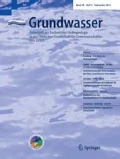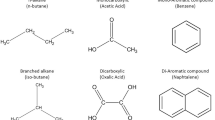Abstract
Commercially available heat transfer fluids used in borehole heat exchangers were investigated for their composition, their biodegradability as well as their ecotoxicity. The main components of the fluids are organic compounds (often glycols) for freezing protection. Biodegradation of the fluids in laboratory studies caused high oxygen depletion as well as nitrate/iron(III) reduction under anaerobic conditions. Additives such as benzotriazoles for corrosion protection were persistent. Ecotoxicity data show that the commercially available fluids caused much higher ecotoxicity than their main organic constituents. Consequently, with regard to groundwater protection pure water as heat transfer medium is recommended. The second best choice is the usage of glycols without any additives. Effects on groundwater quality should be considered during ecological-economical cost-benefit-analyses of further geothermal energy strategies. The protection of groundwater as the most important drinking water resource must take priority over the energy gain from aquifers.
Zusammenfassung
Handelsübliche Geothermie-Wärmeträgerfluide wurden anhand ihrer chemischen Zusammensetzung, ihrer biologischen Abbaubarkeit sowie ihrer Ökotoxizität im Hinblick auf eine mögliche Grundwassergefährdung beurteilt. Hauptbestandteil der Fluide sind organische Substanzen wie z. B. Glykole als Frostschutzmittel. Der biologische Abbau der organischen Bestandteile der Fluide führte in Laborversuchen zu einer hohen Sauerstoff-Zehrung sowie unter anaeroben Bedingungen zu Nitrat-/Eisen-Reduktion. In den Fluiden enthaltene Additive wie Benzotriazole waren persistent. Die Ökotoxizität der Formulierungen im Leuchtbakterienhemmtest und im Fischeitest war gegenüber den organischen Grundsubstanzen deutlich erhöht. Aus Sicht des vorsorgenden Grundwasserschutzes ist die Verwendung von Wasser als Wämeträgerfluid zu empfehlen. Die nächstbeste Alternative ist der Einsatz reiner Glykole ohne Additive. Bei der weiteren Nutzung geothermischer Energie sollten mögliche Auswirkungen auf die Grundwasserqualität in die ökologisch-ökonomische Kosten-Nutzen-Analyse sowie in die behördlichen Entscheidungen über die Zulassung einer Erdwärmenutzung einbezogen werden. Die Trinkwasserversorgung muss immer Vorrang vor der Nutzung des Grundwassers als Energiequelle haben.





Similar content being viewed by others
References
ATSDR—Agency for Toxic Substances & Disease Registry.: Priority list of hazardous substances. http://www.atsdr.cdc.gov/SPL/. Accessed 2 June 2015 (2013)
Bonte, M., Stuyfzand, P.J., Hulsmann, A., van Beelen, P.: Underground thermal energy storage: environmental risks and policy developments in the Netherlands and European Union. Ecol. Soc. 16(1), 22 (2011a)
Bonte, M., Stuyfzand, P.J., van den Berg, G.A., Hijnen, W.A.M.: Effects of aquifer thermal energy storage on groundwater quality and the consequences for drinking water production: a case study from the Netherlands. Water Sci. Technol. 63(9), 1922–1931 (2011b)
Bonte, M., Röling, W.F.M., Zaura, E., van der Wielen, P.W.J.J., Stuyfzand, P.J., van Breukelen, B.M.: Impacts of shallow geothermal energy production on redox processes and microbial communities. Environ. Sci. Technol. 47, 14476–14484 (2013)
Brauch, H.-J., Sacher, F.: Assessment of micro-pollutants from a water supplier’s perspective. Water Res. Manag. 1(1), 17–28 (2011)
Braun, J., Koschitzky, H.-P. (ed.): Flache Geothermie—Perspektiven und Risiken. VEGAS-Kolloquium 2011, 6. Oktober, Stuttgart. Mitteilungen Institut für Wasserbau, Universität Stuttgart 5, ISBN 978-3-942036-09-2 (2011)
Brielmann, H., Griebler, C., Schmidt, S.I., Michel, R., Lueders, T.: Effects of thermal energy discharge on shallow groundwater ecosystems. FEMS Microbiol. Ecol. 68, 273–286 (2009)
Brielmann, H., Lueders, T., Schreglmann, K., Ferraro, F., Avramov, M., Hammerl, V., Blum, P., Bayer, P., Griebler, C.: Oberflächennahe Geothermie und ihre potenziellen Auswirkungen auf Grundwasserökosysteme. Grundwasser 16(2), 77–91 (2011)
Brons, H.J., Griffioen, J., Appelo, C.A.J., Zehnder, A.J.B.: (Bio)geochemical reactions in aquifer material from a thermal energy storage site. Wat. Res. 25(6), 729–736 (1991)
Butscher, C., Huggenberger, P., Auckenthaler, A., Bänninger, D.: Risikoorientierte Bewilligung von Erdwärmesonden. Grundwasser 16(1), 13–24 (2011)
Corsi, S.R., Geis, S.W., Loyo-Rosales, J.E., Rice, C.P.: Aquatic toxicity of nine aircraft deicer and anti-icer formulations and relative toxicity of additive package ingredients alkylphenol ethoxylates and 4,5-methyl-1H-benzotriazoles. Environ. Sci. Technol. 40(23), 7409–7415 (2006)
DIN Deutsches Institut für Normung e. V.: DIN 38415-6: German standard methods for the examination of water, waste water and sludge—Subanimal testing (group T)—Part 6: Toxicity to fish; Determination of the non-acute-poisonous effect of waste water to fish eggs by dilution limits (T 6) (2003)
DIN Deutsches Institut für Normung e. V.: DIN EN ISO 11348-1: Water quality—Determination of the inhibitory effect of water samples on the light emission of Vibrio fischeri (Luminescent bacteria test)—Part 1: Method using freshly prepared bacteria (2009)
DVGW, Deutscher Verein des Gas- und Wasserfachs e. V.: Positionspapier zur Erdwärmenutzung in Trinkwassereinzugsgebieten. http://www.dvgw.de/wasser/ressourcenmanagement/gewaesserschutz/erdwaermenutzung/. Accessed 12 June 2015 (2013)
Giger, W., Schaffner C., Kohler, H.-P.E.: Benzotriazole and tolyltriazole as aquatic contaminants. 1. Input and occurrence in rivers and lakes. Environ. Sci. Technol. 40(23), 7186–7192 (2006)
Gruden, C.L., Dow, S.M., Hernandez, M.T.: Fate and toxicity of aircraft deicing fluid additives through anaerobic digestion. Water Environ. Res. 73(1), 72–79 (2001)
GrwV: Verordnung zum Schutz des Grundwassers. http://www.gesetze-im-internet.de/bundesrecht/grwv_2010/gesamt.pdf/. Accessed 12 June 2015 (2010)
Hähnlein, S., Blum, P., Bayer, P.: Oberflächennahe Geothermie—aktuelle rechtliche Situation in Deutschland. Grundwasser 16(2), 69–75 (2011)
Hähnlein, S., Bayer, P, Ferguson, G., Blum, P.: Sustainability and policy for the thermal use of shallow geothermal energy. Energy Policy 59, 914–925 (2013)
Ilieva, D., Haderlein, S.B., Morasch, B.: Grundwassergefährdungspotenzial von Additiven in Wärmeträgerflüssigkeiten aus Erdwärmesonden. Grundwasser 19(4), 263–274 (2014)
Janna, H., Scrimshaw, M.D., Williams, R.J., Churchjley, J., Sumpter, J.P.: From dishwasher to tap? Xenobiotic substances benzotriazole and tolyltriazole in the environment. Environ. Sci. Technol. 45, 3858–3864 (2011)
Jia, Y., Bakken, L.R., Breedveld, G.D., Aagaard, P., Frostegard, A.: Organic compounds that reach subsoil may threaten groundwater quality; effect of benzotriazole on degradation kinetics and microbial community composition. Soil Biol. Biochem. 38, 2543–2556 (2006)
Kent, R.A., Andersen, D., Caux, P.Y., Teed, S.: Canadian water quality guidelines for glycols—An ecotoxicological review of glycols and associated aircraft anti-icing and deicing fluids. Environ. Toxicol. 14, 481–522 (1999)
Klotzbücher, T., Kappler, A., Straub, K.L., Haderlein, S.B.: Biodegradability and groundwater pollutant potential of organic anti-freeze liquids used in borehole heat exchangers. Geothermics 36, 348–361 (2007)
Lovley, D.R., Phillips, E.J.P.: Organic matter mineralization with reduction of ferric iron in anaerobic sediments. Appl. Environ. Microbiol. 51(4), 683–689 (1986)
Reemtsma, T., Miehe, U., Duennbier, U., Jekel, M.: Polar pollutants in municipal wastewater and the water cycle: Occurrence and removal of benzotriazoles. Water Res. 44, 596–604 (2010)
Saner, D., Juraske, R., Kübert, M., Blum, P., Hellweg, S., Bayer, P.: Is it only CO2 that matters? A life cycle perspective on shallow geothermal systems. Renew. Sust. Energ. Rev. 14, 1798–1813 (2010)
Schmidt, K.R., Tiehm, A.: Natural attenuation of chloroethenes: identification of sequential reductive/oxidative biodegradation by microcosm studies. Water Sci. Technol. 58(5), 1137–1145 (2008)
Schmidt, K.R., Augenstein, T., Betting, D., Peterwitz, U., Hollert, H., Conrad, R., Tiehm A.: Geothermie-Wärmeträgerfluide und Grundwasserschutz. Energie Wasser-Praxis 9, 52–55 (2012a)
Schmidt, K.R., Augenstein, T., Betting, D., Tiehm, A.: Wärmeträgerfluide in der Geothermie: Exemplarische Gefährdungsabschätzung anhand von Strukturaufklärung, Abbaubarkeit und Toxizität. In: Aktuelle Themen im Grundwasserschutz. Veröffentlichungen aus dem Technologiezentrum Wasser 52, 127–191, ISSN 1434-5765 (2012b)
Seiler, T.B., Best, N., Fernqvist, M.M., Hercht, H., Smith, K.E., Braunbeck, T., Mayer, P., Hollert, H.: PAH toxicity at aqueous solubility in the fish embryo test with Danio rerio using passive dosing. Chemosphere 112, 77–84 (2014)
Stein, H., Kellermann, C., Schmidt, S.I., Brielmann, H., Steube, C., Berkhoff, S.E., Fuchs, A., Hahn, H.J., Thulind, B., Griebler, C.: The potential use of fauna and bacteria as ecological indicators for the assessment of groundwater quality. J. Environ. Monit. 12, 242–254 (2010)
Steube, C., Richter, S., Griebler, C.: First attempts towards an integrative concept for the ecological assessment of groundwater ecosystems. Hydrogeol. J. 17, 23–35 (2009)
Strahle, U., Scholz, S., Geisler, R., Greiner, P., Hollert, H., Rastegar, S., Schumacher, A., Selderslaghs, I., Weiss, C., Witters, H., Braunbeck, T.: Zebrafish embryos as an alternative to animal experiments—a commentary on the definition of the onset of protected life stages in animal welfare regulations. Reprod Toxicol. 33, 128–32 (2012)
Tiehm, A., Schmidt, K.R.: Sequential anaerobic/aerobic biodegradation of chloroethenes—aspects of field application. Curr. Opin. Biotechnol. 22(3), 415–421 (2011)
Tiehm, A., Müller, A., Alt, S., Jacob, H., Schad, H., Weingran, C.: Development of a groundwater biobarrier for the removal of polycyclic aromatic hydrocarbons, BTEX, and heterocyclic hydrocarbons. Water Sci. Technol. 58(7), 1349–1355 (2008)
Tiehm, A., Schmidt, N., Stieber, M., Sacher, F., Wolf, L., Hoetzl, H.: Biodegradation of pharmaceutical compounds and their occurrence in the Jordan Valley. Water Resour. Manage. 25, 1195–1203 (2011)
Thoma, A., Graf, C., Kurzenberger, I., Sacher, F.: Benzotriazole im Rhein—Vorkommen und Bedeutung für die Trinkwasserversorgung. ARW-Jahresbericht 2010 67, 99–122 (2011)
U.S. National Library of Medicine: TOXNET—Toxicology Data Network. http://toxnet.nlm.nih.gov/cgi-bin/sis/search2/f?./temp/~4mSySX:1. Accessed 2 June 2015 (2015)
Voutsa, D., Hartmann, P., Schaffner, C., Giger, W.: Benzotriazoles, alkylphenols and bisphenol A in municipal wastewaters and in the Glatt River, Switzerland. Environ. Sci. Pollut. Res. 13(5), 333–341 (2006)
Weber, W.H., Müller, A., Weiß, C., Seitz W., Schulz, W.: 1H-Benzotriazol und Tolyltriazole in der aquatischen Umwelt—Vorkommen in Grund-, Oberflächen- und Abwasser im Gebiet Donauried-Hürbe. Vom Wasser 107(4), 3–34 (2009)
Weiss, S., Jakobs, J., Reemtsma, T.: Discharge of three benzotriazole corrosion inhibitors with municipal wastewater and improvements by membrane bioreactor treatment and ozonation. Environ. Sci. Technol. 40(23), 7193–7199 (2006)
Wolschke, H., Xie, Z., Möller, A., Sturm, R., Ebinghaus, R.: Occurrence, distribution and fluxes of benzotriazoles along the German large river basins into the North Sea. Water Res. 45, 6259–6266 (2011)
Acknowledgments
We gratefully acknowledge financial support from the DVGW (Deutscher Verein des Gas- und Wasserfaches e.V., German Technical and Scientific Association for Gas and Water) and the Innovationsfonds Klima- und Wasserschutz of the badenova AG & Co. KG.
Author information
Authors and Affiliations
Corresponding author
Additional information
An erratum to this article is available at http://dx.doi.org/10.1007/s00767-017-0360-5.
Rights and permissions
About this article
Cite this article
Schmidt, K.R., Körner, B., Sacher, F. et al. Biodegradability and ecotoxicity of commercially available geothermal heat transfer fluids. Grundwasser 21, 59–67 (2016). https://doi.org/10.1007/s00767-015-0311-y
Received:
Revised:
Published:
Issue Date:
DOI: https://doi.org/10.1007/s00767-015-0311-y




